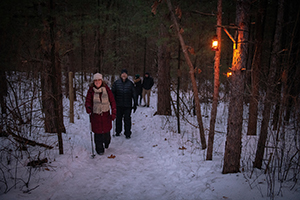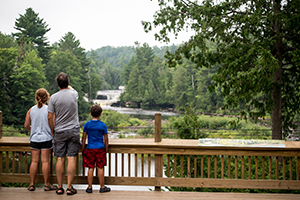Reflecting on the centennial year – an open letter from the Parks and Recreation Division chief
By RON OLSON
Michigan Department of Natural Resources

When was the first time you fell in love with Michigan’s out-of-doors?
Most people – whether longtime residents or those here just for a visit – have had that moment when a picture-perfect blue sky, a sweeping shoreline vista, the silence of an old-growth forest or the sound of rushing water has taken their breath away.
This past year we celebrated these wondrous features of our state, and the people who gather amid them, during our state parks centennial.
Michigan state parks, forests, trails and waterways are at the core of the spirit of this Great Lakes state, and we are working hard to ensure that they endure for another century.
On May 12, 1919, the Michigan Legislature created the state parks system with the establishment of the Michigan State Parks Commission. This legislative act not only moved forward a vision to acquire lands to create quality public outdoor spaces but helped shape an important aspect of Michigan’s heritage.
Our state parks fused together the public’s desire for recreation, relaxation and rejuvenation with opportunities to make lasting memories – enjoying experiences outdoors with Michigan’s spectacular scenic beauty as a backdrop.
|

A drive through Holly Recreation Area or Sleepy Hollow State Park evokes memories of Sunday afternoons and gingham picnic blankets. A hike along the path to the brink of the Tahquamenon Falls or a weekend spent on the soft sands in front of Ludington State Park’s historic beach house may recall memories of special times spent with family and friends.
It’s for this reason that the Michigan state parks centennial celebration centered around the personal memories and shared experiences that connect so many of us.
As the year closed, we had an opportunity to step back and ask what it will take to ensure our state parks are sustainable and protected for decades to come.
We thought a lot about why we do what we do.
After combing through many of the snapshots and stories submitted by the public to our online memory map, hearing anecdotes shared at campfire storytelling events and seeing the artwork created by plein air painters – all the result of 2019’s centennial celebration programming – it’s easier to peel back the layers to see the heart of what we do and why.
Our natural resources stewardship work, stellar recreation facilities and resource conservation efforts are indeed pillars of Michigan’s state parks system, but our backbone is our 28 million annual visitors.
Throughout the yearlong centennial celebration, we were increasingly made aware that state parks play an integral role in Michigan culture. These unique outdoor spaces have become memory-making destinations for so many people.
Another idea we have considered is how to become even more relevant to current and future generations of state park users.
|

As we strive to sustain world-class outdoor recreation opportunities, protect and preserve our natural and cultural resources and maintain an engaging culture within our DNR staff, how do we move the needle toward greater connection and relevancy?
In many ways, attaining that accomplishment will be realized by reversing the order of these important goals.
First, we must continue to attract and retain the best and brightest DNR staff members who are passionate about natural and cultural resources.
In doing that, I am assured staff will continue to seek innovative ways to protect and conserve resources, while also creating engaging ways for people to experience and appreciate the outdoors, and by extension, our 103 Michigan state parks.
Lantern-lit hikes, dark-sky events, water parks, the Bob Ross virtual 5K, storytelling events and Detroit’s Outdoor Adventure Center are just a few of the ways DNR staffers have put their heads together to expand outdoor experiences in entirely new ways.
The many interpreters, park managers, rangers and our business partners all work hard to maintain the many traditional ways park visitors experience the outdoors, while sometimes shifting their focus to discover new ways to offer quality outdoor experiences.
In addition, as we continue to sustain outdoor recreation opportunities in Michigan and maintain good stewardship practices, we’ve embraced “sustainable contraction” – a strategic concept that identifies new opportunities to provide improved access or recreational opportunities.
Recent campground upgrades at Wilderness State Park are a great example of this strategy being implemented.
Based on a shift in today’s camping tendencies, we recently integrated additional full-hook-up options for recreational vehicles at the park, rather than building an additional new bathroom and shower facility.
This shift in infrastructure development allowed us to better serve our customers while spending less money on renovations.
|

The foundation laid 100 years ago by the Michigan State Parks Commission has produced a beloved and substantial system of state parks, pathways and scenic sites.
Moving forward, we will continue to be guided by some of those same early tenets adopted by the commission – sustainability, conservation and expansion.
Conservation will help ensure the existence and prosperity of these special outdoor spaces for the next 100 years. Sustainability allows for innovation to achieve goals appropriate for the broadest group possible. Expansion will continue to allow the state parks system to remain nimble and develop as needed.
From that pathway along the rushing roar of the Tahquamenon River to the sandy beaches at Ludington, and to dozens of other special places scattered across Michigan, it is for our park visitors of today and tomorrow that we remain faithful stewards, conserving our natural resources and keeping state parks favored as phenomenal memory-making destinations.
|
Check out previous Showcasing the DNR stories in our archive at Michigan.gov/DNRStories. To subscribe to upcoming Showcasing articles, sign up for free email delivery at Michigan.gov/DNR.
/Note to editors: Contact: John Pepin, Showcasing the DNR series editor, 906-226-1352. Accompanying photos and a text-only version of this story are available below for download. Caption information follows. Credit Michigan Department of Natural Resources, unless otherwise noted.
Text-only version of this story.
Family: A family takes in the scenic Lower Falls at Tahquamenon Falls State Park in the eastern Upper Peninsula, among the many memory-making destinations in Michigan state parks.
Lantern: Lantern-lit hikes, like this snowshoe hike at Island Lake State Recreation Area in Livingston County, are among the new outdoor experiences Department of Natural Resources staffers have implemented at state parks in recent years.
Ludington: A young visitor makes a memory at Ludington State Park in Mason County, looking out over Lake Michigan from the park’s historic beach house.
Olson: DNR Parks and Recreation Division Chief Ron Olson with his son-in-law Rob Myers, granddaughters Julia Myers and Emily Meyers, and daughter Erika Myers at Belle Isle Park for the Motor City Triathlon.
Storytelling: A series of campfire storytelling events, including this one held at Interlochen State Park in Grand Traverse County, and other state parks centennial programs in 2019 offered insight into the integral role the parks play in Michigan culture.
Tahquamenon: Winter view of the Upper Tahquamenon Falls, one of Michigan’s most photographed places./
|